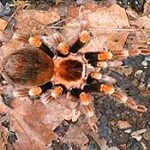Tarantulas mainly eat insects and other arthropods, using ambush as their primary method of prey capture. The biggest tarantulas can kill animals as large as lizards, mice, and birds. Tarantulas are found in tropical and desert regions around the world. Most tarantulas are harmless to humans, and some species are popular in the exotic pet trade. All tarantulas are venomous, but only some species have venom that, while not known to have ever produced human fatalities, can produce extreme discomfort over a period of several days.
The majority of North American tarantulas are brown. Elsewhere have been found species colored cobalt blue (Haplopelma lividum), black with white stripes (Aphonopelma seemanni), yellow leg markings (Eupalaestrus campestratus), metallic blue legs with vibrant orange abdomen and greenbottle blue (Chromatopelma cyaneopubescens). Their natural habitats include savanna, grasslands such as the pampas, rainforests, deserts, scrubland, mountains, and cloud forests. They are generally divided into terrestrial types that frequently make burrows and arboreal types that build tented shelters well off the ground.
Despite their often threatening appearance and reputation, no tarantula has been known to have a bite that is deadly to humans. In general, the effects of the bites of all kinds of tarantula are not well known. While the bites of many species are known to be no worse than a wasp sting, accounts of bites by some species are reported to be very painful and to produce intense spasms that may recur over a period of several days. In all cases, it is prudent to seek medical aid. Because other proteins are included when a toxin is injected, some individuals may suffer severe symptoms due to an allergic reaction rather than to the venom. Such allergic effects can be life-threatening.
Before biting, tarantulas may signal their intention to attack by rearing up into a “threat posture”, which may involve raising their prosoma and lifting their front legs into the air, spreading and extending their fangs, and (in certain species) making a loud hissing by stridulating. Their next step, short of biting, may be to slap down on the intruder with their raised front legs. If that response fails to deter the attacker, the tarantulas of the Americas may next turn away and flick urticating hairs toward the pursuing predator. The next response may be leave the scene entirely, but, especially if there is no line of retreat, their final response may also be to whirl suddenly and bite. Some tarantulas are well known to give “dry bites,” i.e., they may defensively bite some animal that intrudes on their space and threatens them, but they will not pump venom into the wound.
While no fatalities have been attributed to tarantula bites, sometimes spider bites are regarded as the probable source of infections. Medical advice regarding prophylaxis may be helpful in that regard. In addition, there is considerable anecdotal evidence[citation needed] indicating that the venoms of some old-world species can produce symptoms so severe that medical treatment would be appropriate. Medical intervention is also regarded as appropriate when symptoms such as breathing difficulty or chest pain develop, since these conditions may indicate an anaphylactic reaction. As with bee stings, allergic reactions to protein fractions may be many times more dangerous than the direct toxic effects of the venom.

